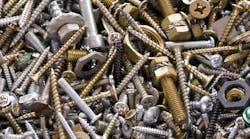This article was updated April 20, 2023. It was originally published Aug. 3, 2016.
RELATED
10 Ways to Use the Ubiquitous Retaining Ring
A Gallery of Self-Tapping Screws
Bolts, Bolts, Bolts: A Gallery
Anodizing. An acid dip that gives parts a frosty, etched appearance. It provides good corrosion resistance, and parts can be color dipped after being anodized. It can only be used on aluminum.
Black oxide. A chemical treatment that gives fasteners a black finish that does not add thickness to parts, nor does it provide corrosion resistance. However, parts usually undergo an oil dip after being treated, and it delivers some corrosion resistance. Black oxide can only be applied to ferrous fasteners.
Cadmium. This bright or dull silver-grey plating gives parts excellent corrosion resistance. It is often used on parts for marine and aviation applications. On the downside, the process is costly and potentially hazardous to the environment. Any metal can be electroplated with cadmium.
Chromate. This is a secondary dipping process used on zinc or cadmium-plated fasteners. It increases corrosion resistance and can be colored. Standard clear chromate leaves a bluish-white hue; other colors such as yellow, olive drab and black are also available.
Chromium. This hard, lustrous bright blue or white finish provides wear and corrosion resistance on all metals, but it is expensive.
Iridite. If a metal part has been coated with zinc or cadmium, it can also be given a finish of iridite to add even more corrosion protection. This coating can also change the color of the fastener to olive drab, green, black, red, blue or bronze finish.
Nickel. This hard, stable and relatively expensive finish leaves a silver color on all metals and good corrosion protection. However, it can be difficult to apply.
Passivating. This process is carried out by dipping stainless steel parts in nitric acid. The acid removes iron particles and brightens the finish. It also produces a passive corrosion-resistant finish.
Phosphate and oil. This low-cost coating combines zinc or manganese phosphate with a rust-inhibiting oil dip. It leaves parts with a charcoal grey or black finish.
Zinc. It is the most commonly used plating. It leaves a white to blue-grey finish and costs little to apply. It is compatible with all metals.
Zinc electroplating. Any metal can be electroplated with zinc. It is one of the most widely used plating finishes, providing an attractive, low-cost finish. Chromate is typically added to increase corrosion resistance and, if desired, add color.
Hot dip zinc. Metal parts are galvanized by being dipped in pure molten zinc. It leaves a dull grey finish that protects against corrosion. It also adds a thick, irregular coating, so the size of parts may need to be adjusted to compensate.
Mechanical zinc. Parts are tumbled in zinc powder, and the peening action of the tumbling embeds powdered zinc into the part’s surface. This creates a thicker and somewhat irregular coating compared to electroplating. As with parts that undergo hot-dip zinc, parts must be sized appropriately to allow for the thickness of the coating.
David Zimmermann was president of Pivot Point Inc. when this article was originally published.
